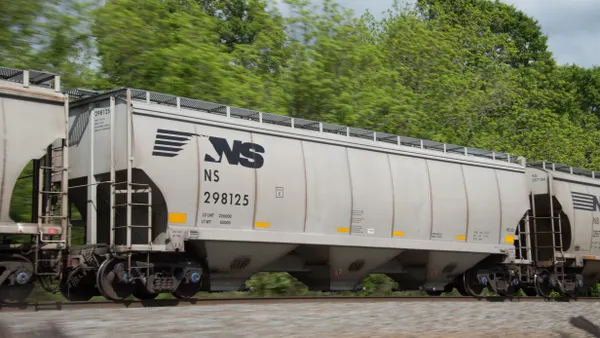Dive Brief:
- Union Pacific's volume has fallen 23% so far in the second quarter as a result of the "ongoing economic impact of COVID-19," the company's CFO Jennifer Hamann said last week during the 13th Annual Wolfe Virtual Global Transportation & Industrials Conference. "It is unlikely we can improve our second quarter operating ratio on a year-over-year basis with that level of volume loss," Hamann said.
- "The biggest decline has been in our premium business as the impact of the auto plant shutdown, and overall consumer demand has led to a 30% decline [in volume]," she said.
- Auto volume was down 85% in the current quarter to date, she said on May 20. Plants are beginning to reopen, but increased volume is expected to reappear slowly as manufacturers work through their current inventory, she said.
Dive Insight:
Union Pacific has pulled capacity from the marketplace as volume has fallen, reducing train starts in the "mid 30% range" in the second quarter, company CEO Lance Fritz said Wednesday on a call with Bernstein analysts.
Hamann said the company has reduced train starts "at a faster rate than we've seen volume decline."
"You could do more to pull back train starts, but at some point that's going to have an impact on your customer service product. So, we want to make sure we're not pushing too hard on one and causing problems for our customers on the other side," she said.
Overall rail volume was down almost 21% year over year in week 20 (May 11 to May 17), according to UBS. "We note that auto plants have begun to reopen at reduced capacity and we expect to see some incremental lift in rail volumes in Week 21," UBS said in a research note last week.
One challenge for rail companies is cutting costs while maintaining enough capacity to take on volume when the market recovers, Norfolk Southern CFO Mark George said during a presentation at the conference last week. Norfolk Southern's quarter-to-date volume is down 30%, George said.
CSX has also taken steps to "rightsize" the network as a result of the volume decline, EVP of Sales and Marketing Mark Wallace said at the same conference. CSX's volume was down 22% quarter to date at the time of the event.
Volume will need to "come back quite a bit" to reach Norfolk Southern's goal of an operating ratio of under 60 in 2021, Georg said.
CSX is also looking to the restart in the auto sector as a potential bright spot but acknowledged it could be a slow start. GM announced this week "they expect to be back to full production by the middle of June, the others are taking a wait and see approach," Wallace said.
While volume is leaving the market, Union Pacific highlighted the remaining trips were seeing high levels of train plan compliance: 90% for intermodal and "ballpark 80%" compliance for manifest and automotive, Fritz said.
As the pandemic has unfolded, it has ignited a conversation around nearshoring. Union Pacific sees this as an opportunity, as new shippers would enter the North American market place.
"I know several of our customers are thinking, what are they going to do with their supply chains ... as a reaction to what they've experienced through [COVID-19]," Fritz said. "You hear a lot about on-shoring and reshoring and I think there's an opportunity for some of that to occur."
When Union Pacific's customers begin talking about near- or on-shoring, the rail company can be involved in those conversations when it comes to location, which would allow it to compete for moving freight into or out of that location, >Fritz said.
For a rail company, "it's hard to say whether that's winning or losing, compared to having it land at a port," he said.














